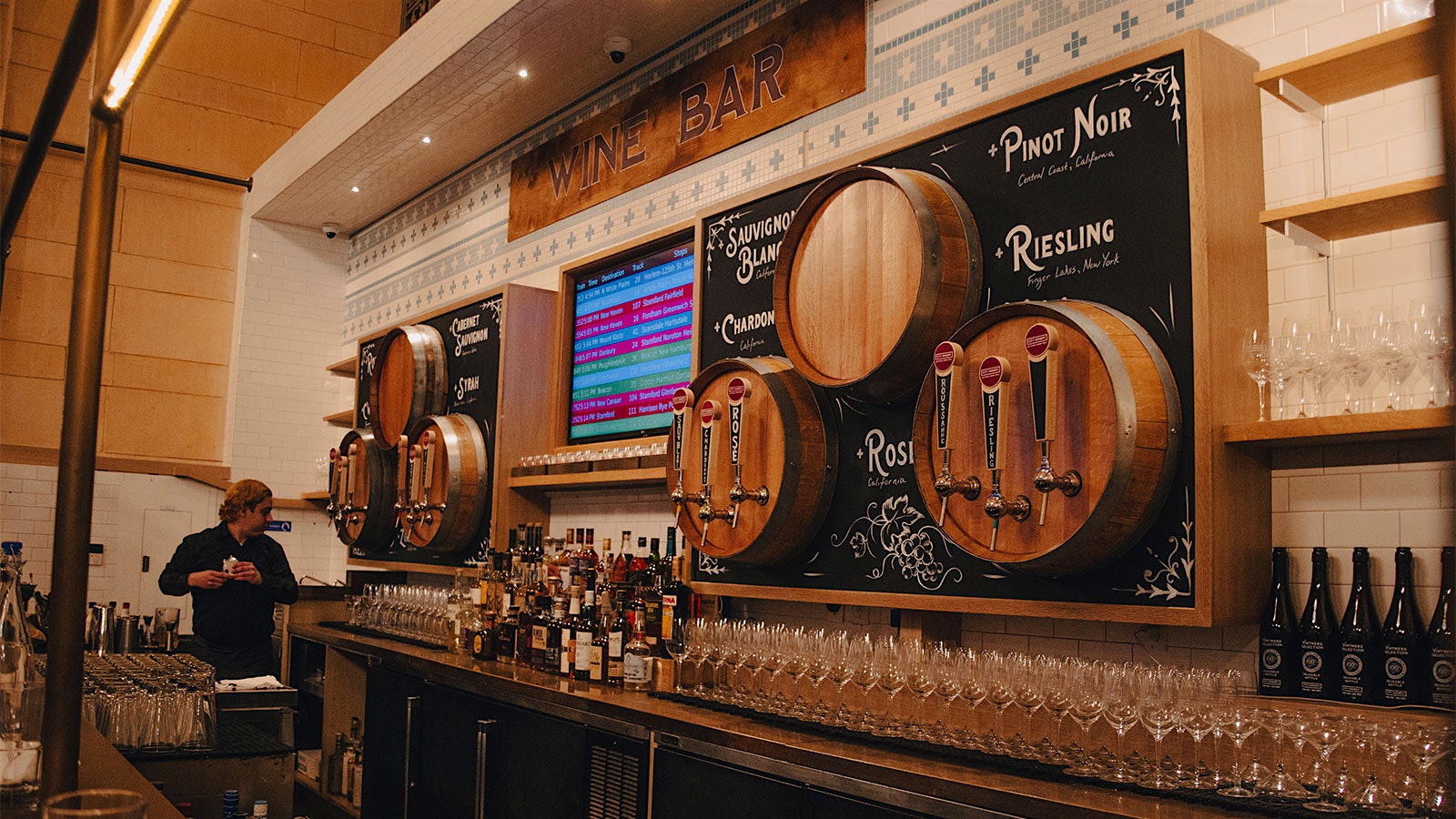With Wine Spectator Restaurant Award–winning locations around the U.S., City Winery is an innovative and leading force for both urban wineries and U.S. hospitality. Now, it’s coming to a New York landmark, Grand Central Terminal. On Nov. 21, the City Winery team opened a new space, its 14th, in the transit hub’s Vanderbilt Hall West, featuring two restaurants, to-go options (including wine), live entertainment and, impressively, on-site winemaking. The space previously housed the Nordic-cuisine Great Northern Food Hall, which closed in 2020.
“I’ve actually never been more excited, on some level, for a launch of a concept,” City Winery founder and CEO Michael Dorf told Wine Spectator. “Not only do I think it makes good business sense, but if we’re somewhat successful—even if we’re marginally successfully—it’s going to raise the bar on how a small, little company can potentially affect how people [interact] with wine.”
The 7,400-square-foot space boasts a 75-seat restaurant, Cornelius (set to open later this month), named for Grand Central Terminal’s founder, Cornelius Vanderbilt. Prepared by executive chef Zachary Bondy, the restaurant’s locally focused, farm-to-table menu will play off Continental-cuisine classics, with oysters Vanderbilt (a take on oysters Rockefeller, sourced from Long Island), salad Lyonnaise, duck confit, beef tartare and, appropriately, a “Wall-Dorf” salad with Hudson Valley apples. “‘Old farm to new table’ is basically our tag,” said Dorf, “It’s got a nod to the historic menus of yesteryear, but obviously with a more [modern twist].”
As with the other locations, the beverage program at Cornelius—and at the space’s two City Winery tasting bars—is primarily focused on City Winery wines from California and New York offered on tap and served by the glass. This includes wines made on site. “Wine, no matter what, is our focal point,” said Dorf. “People are going to walk into Grand Central Station off of 42nd street and they’re going to see a large fermenting tank.” Cornelius’ list will also spotlight producers in regions like Spain and France, as well those practicing eco-friendly techniques. The wine program is overseen by City Winery national beverage director Denise Prykanowski and the wine team from City Winery’s Best of Award of Excellence–winning New York flagship.
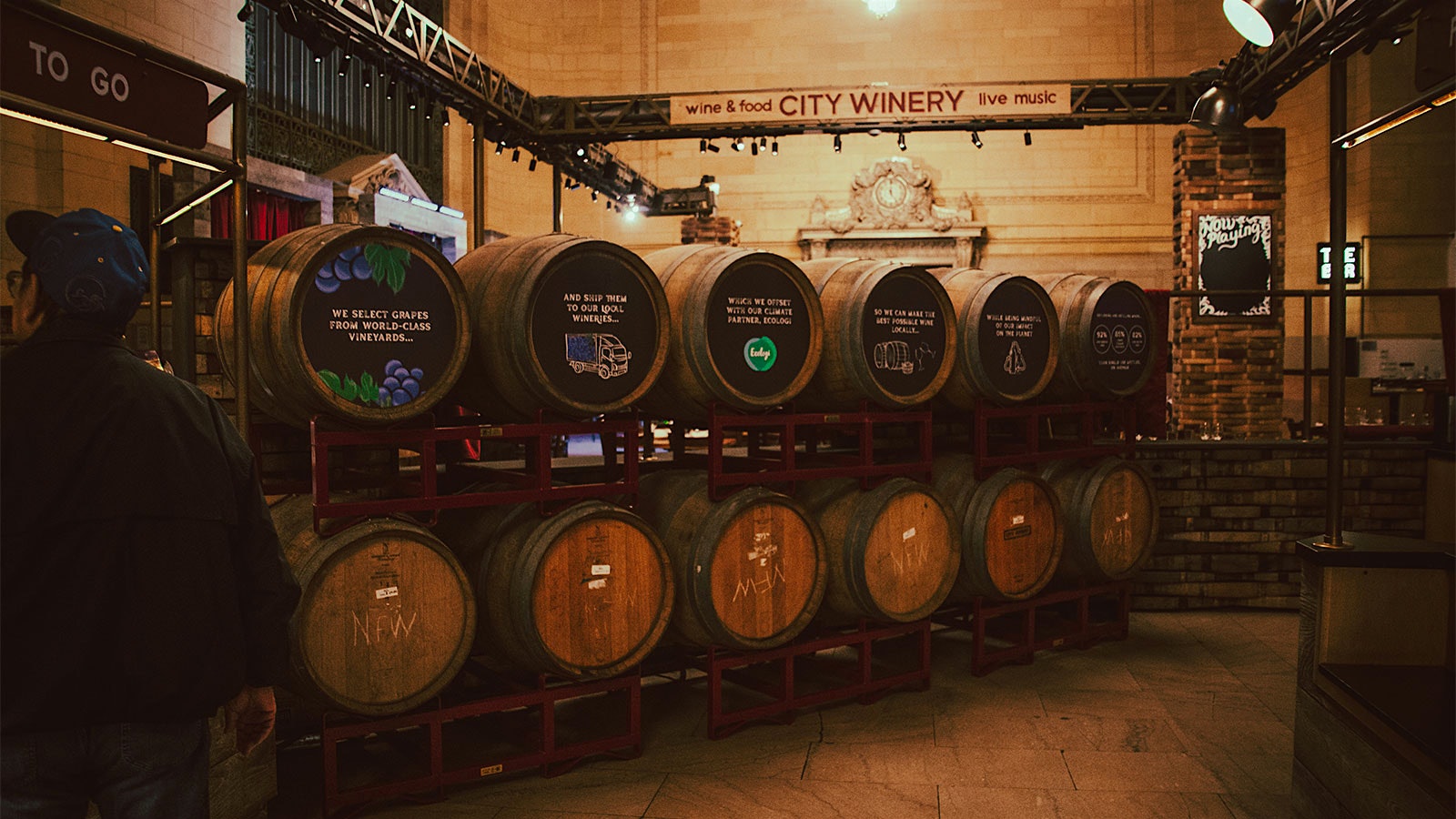
For a more casual affair, diners can go to the now-open City Winery wine bar–restaurant for burgers, flatbreads, shareable plates and more, or to the grab-and-go spot, City Jams, for sandwiches, baked goods, snacks and to-go wine in glass growlers. (Another City Jams spot is located closer to Grand Central’s subway entrances.) Not only does this offer an easy option for guests catching trains, but it adds to the eatery’s sustainability, a key part of City Winery’s ethos; the eatery also gives guests a $5 credit for returning their growlers.
“To me, it’s almost got a historic connection to the way we operated as a consumer culture pre–oil energy and plastic,” Dorf noted. “This is what we did when Cornelius Vanderbilt built Grand Central.”
It wouldn’t be City Winery without live entertainment, and the space will deliver with ambient music for about 190 guests at a time. Dorf hopes the venue can put a spotlight on performers and buskers regularly working in New York train stations.
As for design, the City Winery space complements and recalls the elements of Grand Central Station. “We have, as a company, been very good about adaptive reuse of space,” Dorf explained, observing that City Winery’s Hudson Valley location is located within a historic knitting factory. “We’ve always gone into older buildings, respected the history—frankly, accentuated the history. You know, old brick or old beams.”—C.D.
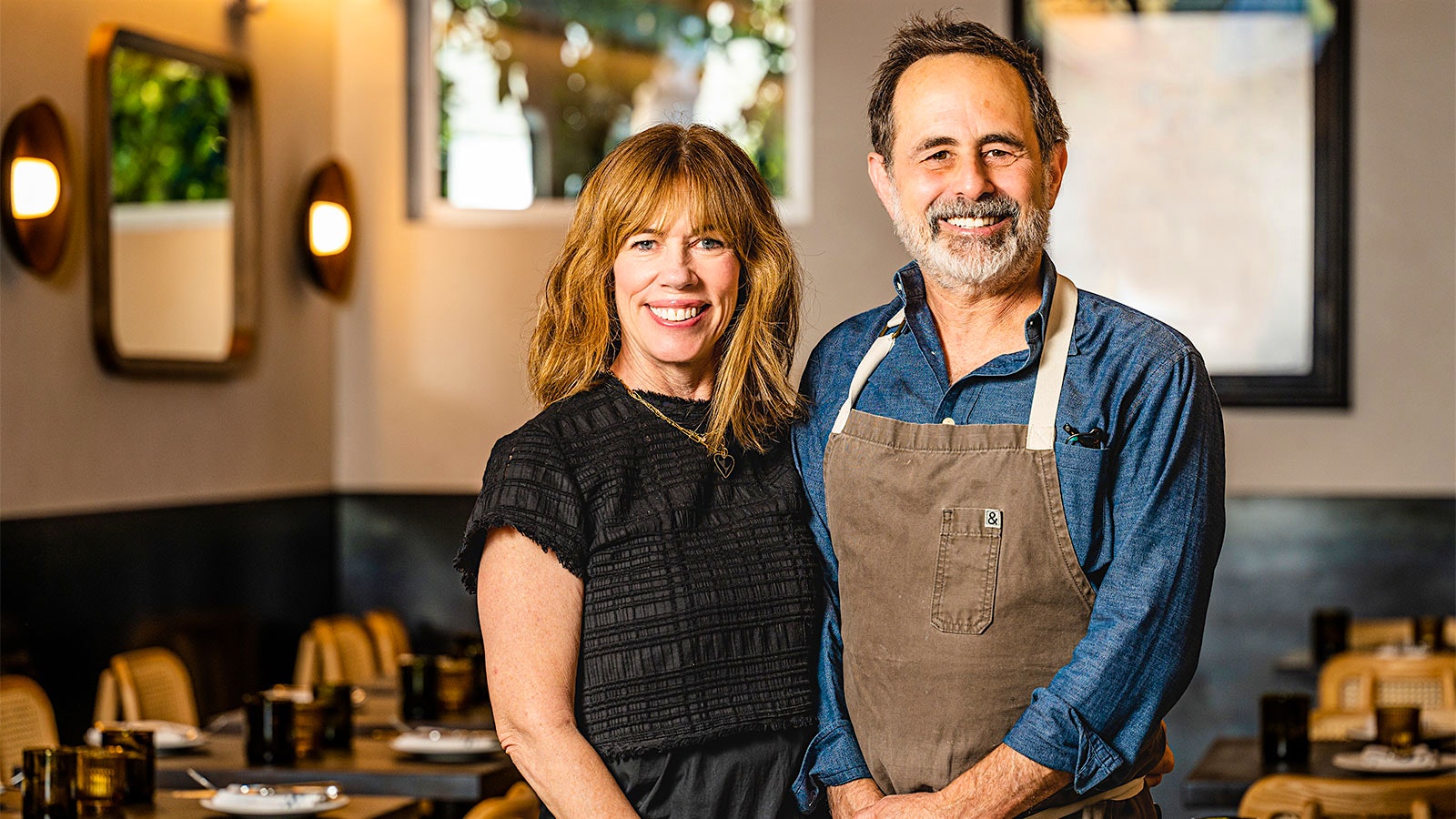
Delfina Returns to San Francisco
Delfina had been an icon of San Francisco’s dining scene for nearly 25 years before closing its dining room at the onset of the pandemic in March 2020. Through much of the pandemic, it served guests exclusively in its parklet, and locals wondered if the beloved Mission District Italian eatery would ever open its doors again.
After two-and-half years, it has fully reopened, perhaps even better than its first iteration. The former Wine Spectator Award of Excellence winner received a facelift and reopened for service on Oct. 26, expanding its square footage by merging with its neighboring sister restaurant, Pizzeria Delfina. The new, open dining room seats 115 and melds modern decor with classic Italian touches, including light brown leather banquettes, mid-century–style pendant lights and red-tinged wood floors. A second dining room features a golden-domed ceiling with tiled floors.
“We’re beyond thrilled with the remodel,” said owners Craig and Annie Stoll in an email to Wine Spectator. “It accomplishes exactly what we set out to create: a sexy, modern and complete transformation of the restaurant, still channeling the fun and warm vibes. Seeing our first baby full of happy guests in a better-than-ever restaurant is incredibly gratifying after two and a half years of darkness,” they added.
Delfina brought back several signature dishes, including spaghetti Pomodoro and grilled Monterey Bay calamari with rice beans. In addition, the Stolls and executive chef John Arcudi have added new items, including house-made focaccia and a menu built around produce from the Stolls’ farm in Sonoma.
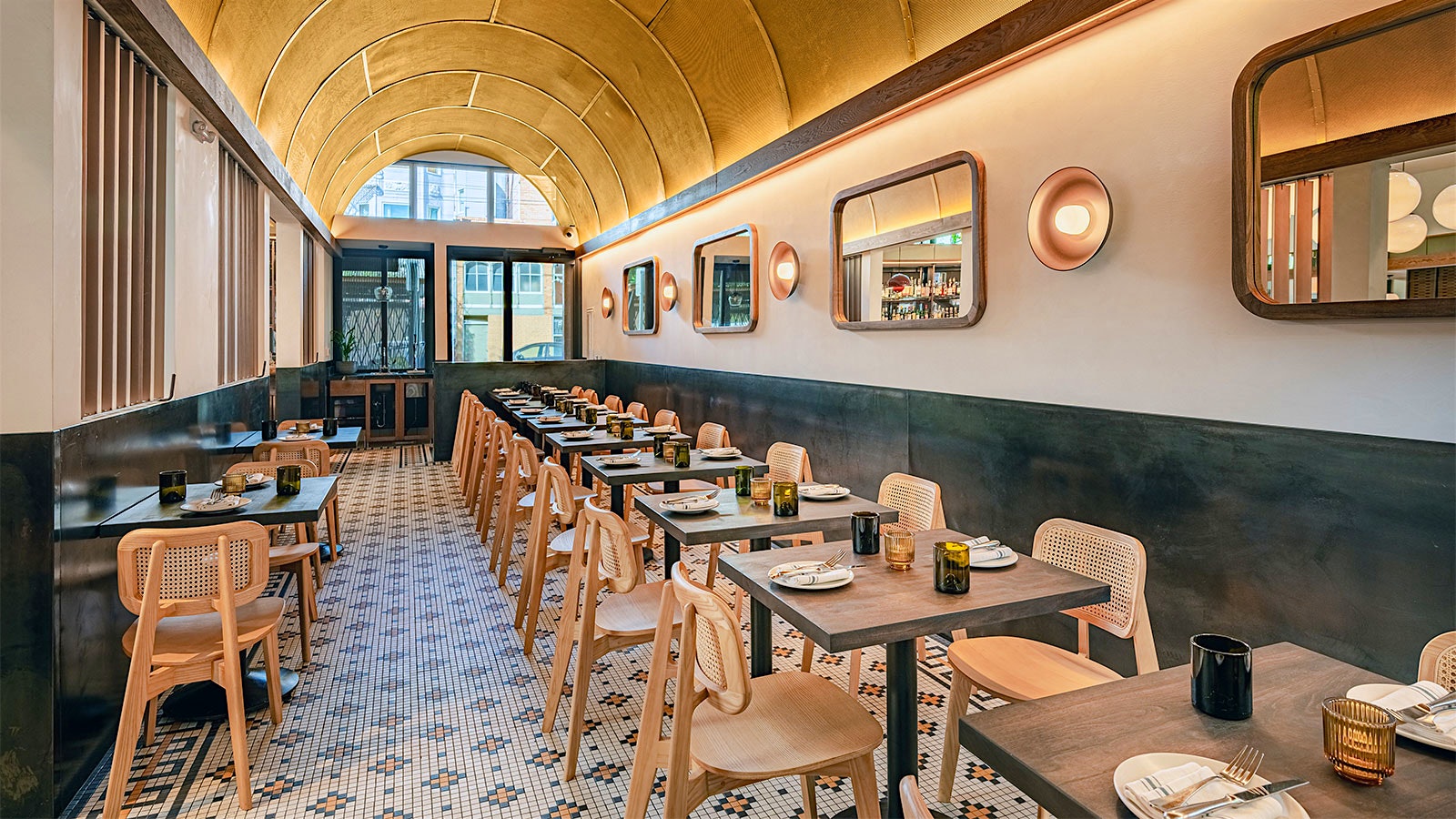
The restaurant also added a new Italian-inspired cocktail program, joining its concise-but-thoughtful wine list of around 60 wines. Curated by consulting wine director James Butler, the list is exclusively devoted to Italian and California selections and grounded in offerings from Piedmont and Tuscany.
“Delfina’s previous wine list was pretty deep, but we needed to recontextualize the inventory. We don’t know how people are spending during this post-pandemic period,” said Butler. Because of that, the wine list offers tons of value options, such as Piedmont’s Luca Ferraris Ruché di Castagnole Monferrato Sant’Eufemia 2021 ($48) or a magnum of Isole & Olena Chianti Classico 2015 for $100.
The wine menu is user-friendly, broken into categories such as “clean, lean and mineral” or “structured, elegant and bold,” with the idea of empowering diners. Butler noted it was tricky to inherit existing inventory and ensure it didn’t overshadow the new wines he was bringing on, so he is creating a reserve list of around 25 wines that will include older vintages.—A.R.
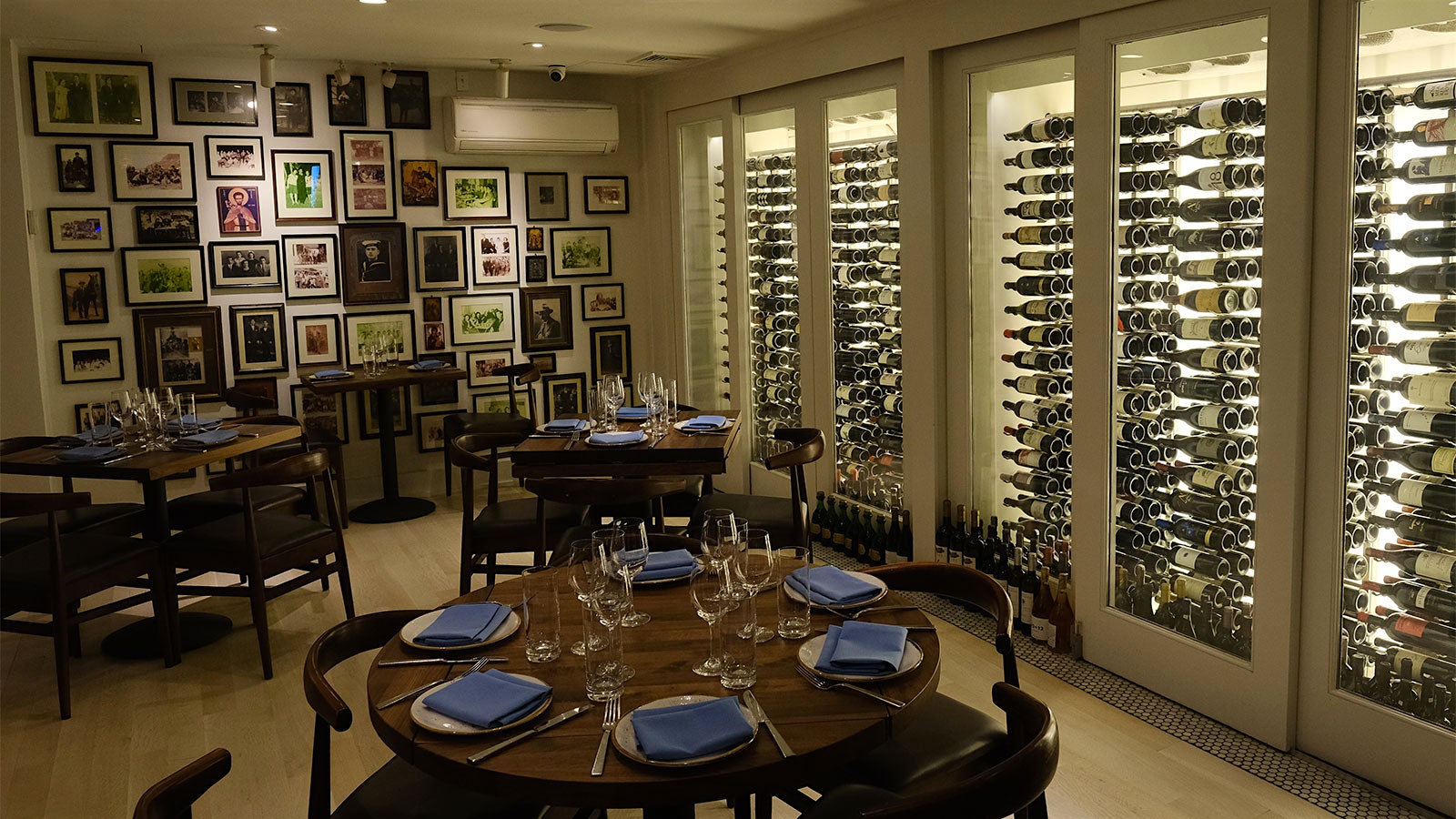
Molyvos Reopens at New Hell’s Kitchen Location
For nearly 25 years, Best of Award of Excellence winner Molyvos delighted the hungry wanderers of Midtown Manhattan at its location on Seventh Avenue and 55th Street, just south of Carnegie Hall. When the restaurant closed during the pandemic, New York temporarily lost one of its most important advocates for Greek cuisine—and Greek wine. With its reopening, in the intimate 43rd Street space formerly occupied by seafood destination Esca, diners seeking Greek in Gotham can breathe easy.
The restaurant’s soft opening menu is divided into four parts: traditional spreads; a new section devoted to raw, chilled and marinated seafood; salads and appetizers (including meatballs and grilled octopus); and a smattering of classic entrees, among them dolmades (Napa cabbage stuffed with lamb, beef and pork), moussaka and roasted chicken. The menu will expand to include additional entrees and grilled selections, including a whole fish.
Longtime wine director Kamal Kouiri’s list features over 750 wines—all of them Greek—with 30 by-the-glass offerings and a cellar of nearly 10,000 bottles. Kouiri told Wine Spectator, “During my 21 years at Molyvos, I was able to collect and develop verticals [of] some amazing wines, highlighting the versatility of the indigenous grape varieties, the terroir [and the] savoir faire of amazing people.”
Start with a Greek spirit (the list boasts an entire page, full of rare finds) or a glass of retsina, the ancient style of white wine infused with pine resin. Greek wine aficionados will find plenty of familiar friends here—Xinomavro, Assyrtiko, Agiorgitiko and more abound—plus unknown and unexpected finds from across the country, from northern Macedonia to southern Crete. Diners who prefer to stick with the familiar won’t be disappointed either; many of the wines are based on internationally popular grapes such as Cabernet Sauvignon, Syrah and Chardonnay. And while there are plenty of splurge-worthy bottles—perhaps one of the many mature magnums on offer?—the number of wines under $100, including many in the $50 to $75 range, is remarkable, as is the sweet wine selection.
Molyvos regulars may be pleasantly surprised by the new section devoted to natural and skin-contact wines, which joined the list during the move to Hell’s Kitchen. Kouiri reflected, “We believe that Greece, with its nearly 4,000 years of history of making wine, is actually synonymous with the thing we today call ‘natural wine.’ When Aristotle mentions in his writings the wine made from the grape Limnio 2,400 years ago, what he was referring to was most certainly a natural wine. Greece has seen a renaissance with respect to the ancient tradition of winemaking in recent years. We are happy to offer a selection of the best Greece has to offer at Molyvos.”
Molyvos is open for dinner daily from 5–11 p.m., with lunch offered on weekdays from 12–3 p.m.; brunch is planned for the near future.—K.M.
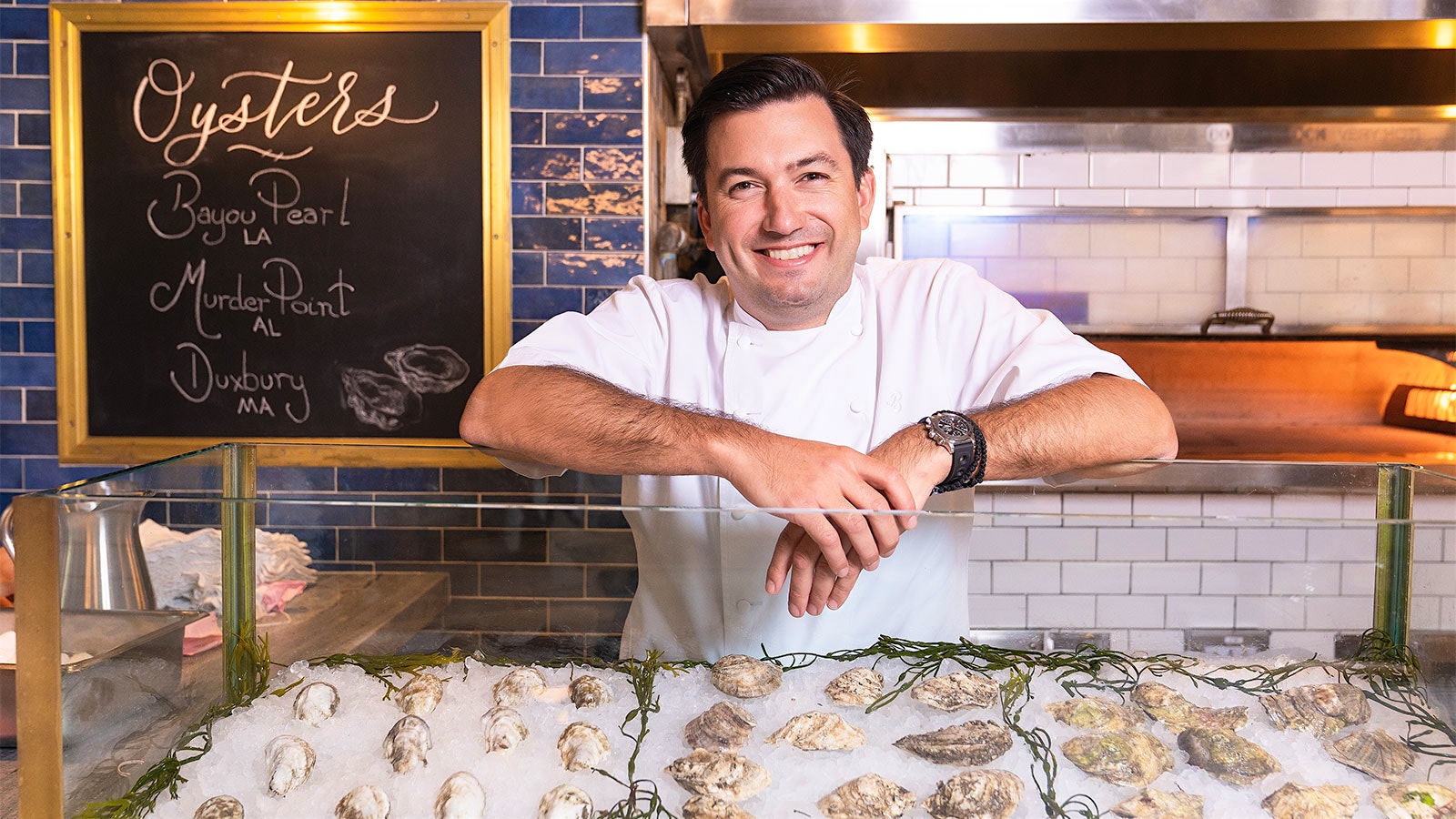
Team Behind Houston’s Bludorn Opens Second Restaurant
Chef Aaron Bludorn opened Bludorn, in Houston, Texas, with fingers crossed in August 2020. At a time when the pandemic had forced many restaurants to close, he knew it was risky, but he didn’t go in expecting to fail. “We opened at a time when Houstonians were looking for hope,” said Bludorn, adding, “We thought it was a big gamble. But it was the right gamble at the right time.”
Two years later, Bludorn has succeeded, while earning a Wine Spectator Best of Award of Excellence for its wine list in 2022. Now Bludorn and his partners—wife Victoria Pappas Bludorn and general manager Cherif Mbjodi—are doubling down with the Nov. 18 debut of Navy Blue, a seafood-focused restaurant with French underpinnings in Houston’s Rice Village neighborhood.
The 7,100-square-foot space evokes an aquatic ambiance, with natural, oceanic tones throughout the 110-seat dining room, which features long tables separated by white oak partitions and plush banquettes. White-grey Japanese ceramic tile and steel driftwood punctuate the bar area. Behind the bar is a flex space that can be used for overflow seating or as a private dining area and features a mural by Austin artist Emily Eisenhardt.
Jerrod Zifchak, Navy Blue’s executive chef, began his career at Grand Award-winning Le Bernardin before working under Bludorn at New York’s now-shuttered Café Boulud, then assuming the executive chef role there after Bludorn’s departure in 2019. Classically French–trained and an avid fisherman, Zifchak is tailor-made for the toque at Navy Blue, where the menu capitalizes on Houston’s proximity to the Gulf of Mexico.
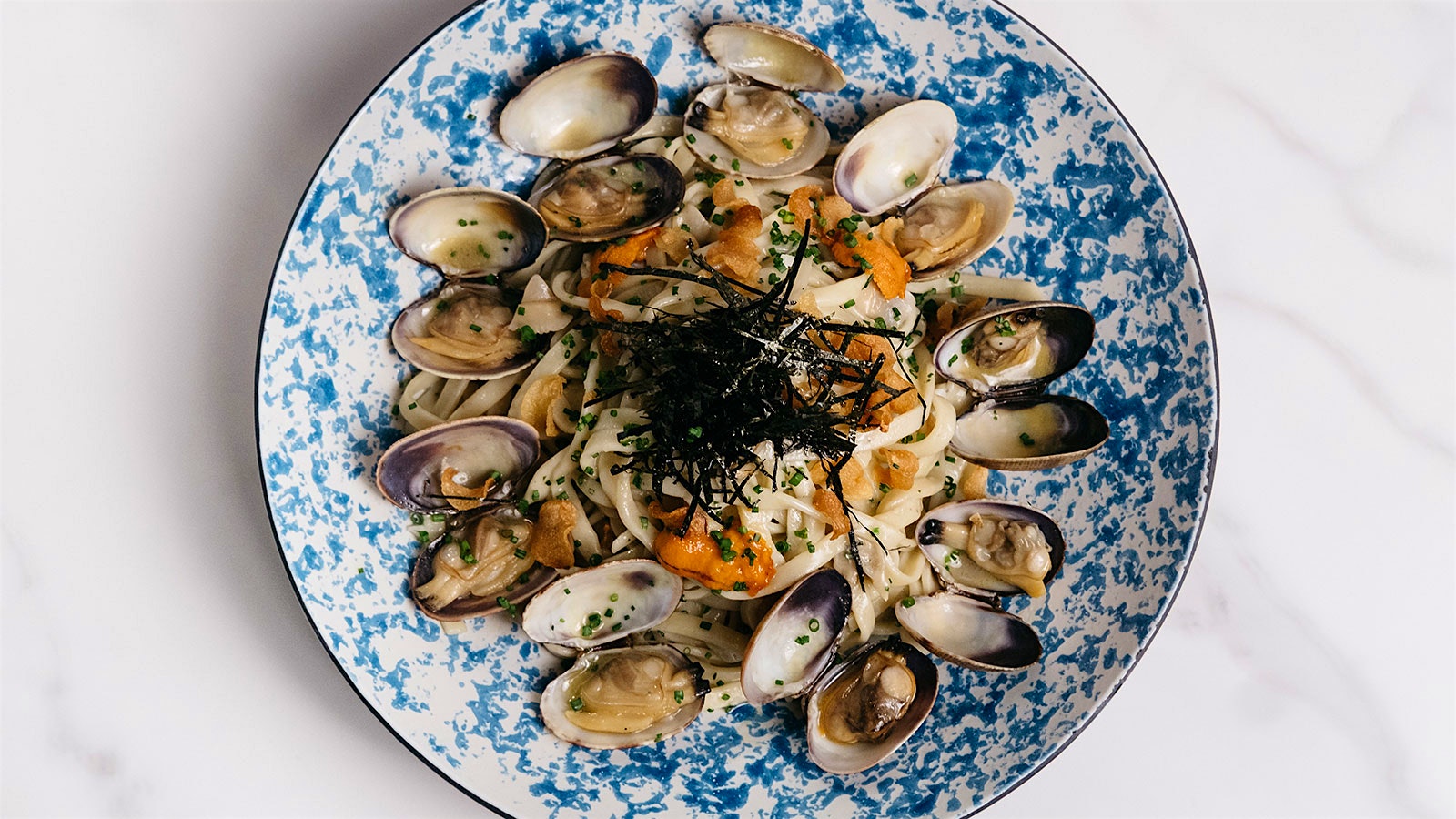
Navy Blue—a name that nods to the ocean, but is also a tribute to Bludorn’s father, a naval aviator whose call sign was “Blue”—borrows from a classic steakhouse format; diners can order fish à la carte and choose accompanying sides, such as potato purée, broccoli rabe or French fries with cod roe mayonnaise. A handful of pasta dishes, soups, salads and large plates round out the menu.
One of Bludorn’s culinary hallmarks is threading the needle of what is expected with a dish while placing his stamp on it. “The more straightforward I am, the more playful I can be,” he said. Diners can expect classic dishes with a twist, such as crab cakes with celeriac rémoulade and bottarga, or spaghetti vongole with Manila clams, sea urchin and seaweed. Swordfish stands in for steak, prepared with green peppercorn sauce.
Adopting from Bludorn restaurant, where diners love ordering oysters every way (raw, fried and poached, with additional accompaniments), Navy Blue features a similar concept. Again, oysters are offered three ways, as well as shrimp (cocktail, fried, BBQ) and clams (casino, fried, steamed). That model is carried over to the main fish, with whole Dover sole served either almondine, Oscar or Provençal, and to a whole lobster, either boiled, grilled or Thermador.
Navy Blue’s beverage program emphasizes cocktails, including modern takes on classics and customizable martinis. Bludorn wine director Molly Austad started with around 160 bottlings, including 20 by the glass. The list focuses heavily on white Burgundy—including bottlings from producers such as Benjamin Leroux, Marc Morey and Michel Niellon—with an abundance of whites from European coastal and island regions. “Our selections are mainly based on wines traditionally paired with seafood from all over the world,” said Austad. “We have a fun selection from Greece, the Canary Islands, Sicily and beyond.” For reds, the focus is on lighter-bodied wines that can complement the seafood. “We have Pinot Noir from California and Oregon, as well as a Trousseau from Santa Barbara and an old-vine Grenache from Australia.”—A.R.
